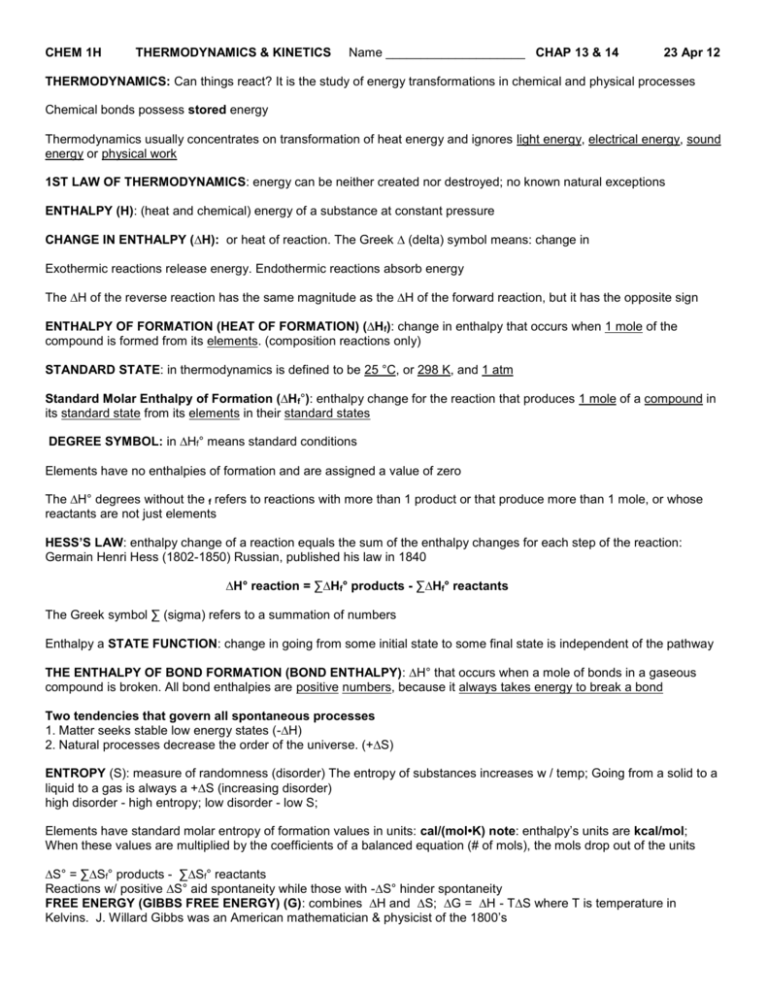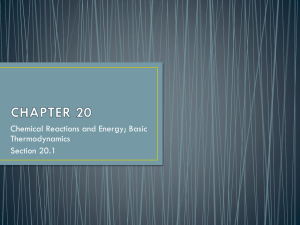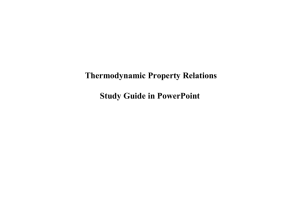Chapter 13 & 14
advertisement

CHEM 1H THERMODYNAMICS & KINETICS Name ____________________ CHAP 13 & 14 23 Apr 12 THERMODYNAMICS: Can things react? It is the study of energy transformations in chemical and physical processes Chemical bonds possess stored energy Thermodynamics usually concentrates on transformation of heat energy and ignores light energy, electrical energy, sound energy or physical work 1ST LAW OF THERMODYNAMICS: energy can be neither created nor destroyed; no known natural exceptions ENTHALPY (H): (heat and chemical) energy of a substance at constant pressure CHANGE IN ENTHALPY (∆H): or heat of reaction. The Greek ∆ (delta) symbol means: change in Exothermic reactions release energy. Endothermic reactions absorb energy The ∆H of the reverse reaction has the same magnitude as the ∆H of the forward reaction, but it has the opposite sign ENTHALPY OF FORMATION (HEAT OF FORMATION) (∆Hf): change in enthalpy that occurs when 1 mole of the compound is formed from its elements. (composition reactions only) STANDARD STATE: in thermodynamics is defined to be 25 °C, or 298 K, and 1 atm Standard Molar Enthalpy of Formation (∆Hf°): enthalpy change for the reaction that produces 1 mole of a compound in its standard state from its elements in their standard states DEGREE SYMBOL: in ∆Hf° means standard conditions Elements have no enthalpies of formation and are assigned a value of zero The ∆H° degrees without the f refers to reactions with more than 1 product or that produce more than 1 mole, or whose reactants are not just elements HESS’S LAW: enthalpy change of a reaction equals the sum of the enthalpy changes for each step of the reaction: Germain Henri Hess (1802-1850) Russian, published his law in 1840 ∆H° reaction = ∑∆Hf° products - ∑∆Hf° reactants The Greek symbol ∑ (sigma) refers to a summation of numbers Enthalpy a STATE FUNCTION: change in going from some initial state to some final state is independent of the pathway THE ENTHALPY OF BOND FORMATION (BOND ENTHALPY): ∆H° that occurs when a mole of bonds in a gaseous compound is broken. All bond enthalpies are positive numbers, because it always takes energy to break a bond Two tendencies that govern all spontaneous processes 1. Matter seeks stable low energy states (-∆H) 2. Natural processes decrease the order of the universe. (+∆S) ENTROPY (S): measure of randomness (disorder) The entropy of substances increases w / temp; Going from a solid to a liquid to a gas is always a +∆S (increasing disorder) high disorder - high entropy; low disorder - low S; Elements have standard molar entropy of formation values in units: cal/(mol•K) note: enthalpy’s units are kcal/mol; When these values are multiplied by the coefficients of a balanced equation (# of mols), the mols drop out of the units ∆S° = ∑∆Sf° products - ∑∆Sf° reactants Reactions w/ positive ∆S° aid spontaneity while those with -∆S° hinder spontaneity FREE ENERGY (GIBBS FREE ENERGY) (G): combines ∆H and ∆S; ∆G = ∆H - T∆S where T is temperature in Kelvins. J. Willard Gibbs was an American mathematician & physicist of the 1800’s -∆G indicates a release of energy and signifies that a reaction might occur naturally Four possible enthalpy / entropy combinations exist 1. exothermic and increasing entropy (- ∆H, + ∆S) may occur naturally 2. exothermic and decreasing entropy (- ∆H, - ∆S) may occur naturally at low temp 3. endothermic and increasing entropy (+ ∆H, + ∆S) may occur naturally at high temp 4. endothermic and decreasing entropy (+ ∆H, - ∆S) does not occur naturally KINETICS: study of the rates of reactions & the steps by which they occur. (Will things react & How fast will they react?) Energy diagrams show what happens during a reaction COLLISION THEORY: any factor that increases the number of effective collisions increases the rate of a reaction Collisions must be: 1. Forceful enough and 2. Properly oriented ACTIVATION ENERGY: minimum amount of kinetic energy that the reactants have before they can react ACTIVATED COMPLEX: unstable intermediate group of reactants that can form products or revert back to reactants Reaction rates: Tell how fast reactants change into products Five variable factors that affect reaction rates: 1. CONCENTRATION: changes affect different reactions in different ways; it depends on the rate law 2. TEMPERATURE: rule of thumb; kinetics; reaction rates double for every 10 °C the temperature rises 3. SURFACE AREA: smaller particles have greater surface area/ unit volume and increase reaction rates (explode). Grain dust in a grain elevator, fine laundry lint particles in washroom, and coal dust in a coal mine can explode 4. CATALYST: substance that changes a reaction rate w/out being permanently changed by the reaction. They lower activation energy by providing bonding site for more effective collisions 5. NATURE OF REACTANTS: some reactants by nature will just react faster SPONTANEOUS COMBUSTION: fires that start w/out a flame or spark from slow oxidation that gradually builds up heat; oily rags, wet hay, paint rags REACTION MECHANISM: series of steps that make up a reaction RATE LAW: equation; mathematically describes how fast a reaction occurs. Can only be experimentally determined H2 + I2 --> 2HI Rate = k[H2][I2] where k is a constant [ ] : brackets indicate concentrations in mol / L Each reaction has its own rate constant (k). Rate laws must be experimentally determined NO2 + CO --> NO + CO2; Rate = k[NO2]2











